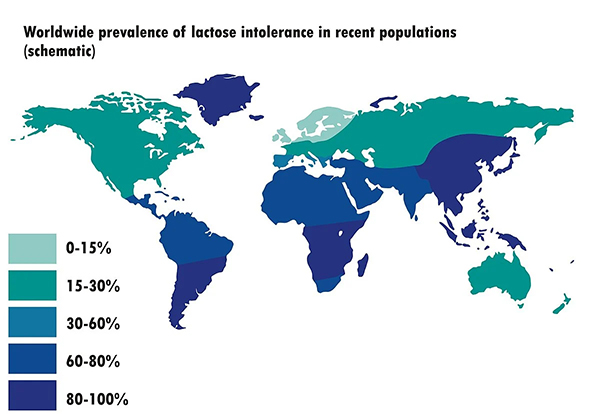Having diarrhea after using exercise supplements is common for many people practicing sports.
At this point, we will think that supportive supplements such as whey or mass from reputable manufacturers make unqualified make you flatulence and diarrhea.
However, if you have purchased products from reputable and verified manufacturers, then the ability of manufacturers to make poor quality products is not available, then the problem of diarrhea or flatulence where?

This article will explain that the whole process is caused by a basic factor that is often found in milk, from the types of milk ingredients for athletes or those simple types of milk is lactose.
So what is lactose, and why lactose is the cause of diarrhea after we use these supplements?
BellyFatZone invites you to learn in this article to have an overview and know how to use it appropriately to overcome diarrhea. View: Best Protein Powder For Muscle Gain
What is lactose?
Lactose is the sugar in cow's milk, dairy products, and breast milk. When lactose is loaded, the small intestine will produce the Lactase enzyme to process this sugar.
If the body is lactose intolerant, it will NOT be able to make enough lactase enzymes and not release lactose. This causes abdominal pain, constant vomiting, or diarrhea.
Lactose allergy is a widespread phenomenon. According to scientific studies, up to 75% of the world's population has this condition, whether severe or mild.
In essence, the human body at birth can produce quite large amounts of the enzyme lactase to digest or process lactose during breastfeeding.
However, the lactase content decreases over time, causing lactose allergy (also known as lactose intolerance).
View more: Whey and Casein Protein Powder
What is lactose allergy?
Lactose allergy is a disorder of the digestive system caused by the inability to digest lactose, the main carbohydrate component in dairy products.
It can cause many different symptoms, including bloating, diarrhea, and abdominal pain.
People who are lactose intolerant often cannot produce enough of the enzyme lactase themselves, a condition needed to digest lactose.
Lactose is a type of double sugar, meaning it consists of two types of sugar. It is made up of a molecule of two simple sugars, glucose and galactose.
The lactase enzyme is needed to break down lactose into glucose and galactose, which can then be absorbed into the bloodstream and used for energy.
Without sufficient lactase levels, lactose will pass through your stomach without treatment and cause discomfort to the digestive system.
Lactose is also found in breast milk, and most people are born to digest it. Lactose intolerance is rare in children under the age of 5.

Currently, about 75% of the world's population has a lactose allergy. The risks will vary from country to country, as can be seen on the map below.
Read more: Plant Protein Powder – You Can Make It Yourself At Home.
The causes of lactose allergy
First, we need to understand the types of lactose intolerance, with the two main types and the different causes.
1. The main lactose allergy
This is the most common phenomenon due to a decrease in lactase content produced by age. As a result, lactose becomes harder to absorb into the body.
A gene can cause this type of lactose allergy because this is a common cause for many people compared to other causes.
Population studies have estimated that lactose allergy affects 5-17% of Europeans, about 44% of Americans, and 60-80% of Africans and Asians.
2. Secondary lactose allergy
This phenomenon is quite rare due to illnesses, such as stomach pain, or a more serious illness such as celiac disease.
This is because inflammation in the intestinal wall can temporarily reduce lactase production.
Read more: How to Make Protein Bars at Home for Weight Loss?
How do you know if you're allergic to lactose?
If you experience abdominal pain, bloating, and diarrhea after drinking milk or eating dairy products, your doctor will probably want to conduct some additional tests to determine if you are allergic to lactose. Ways to check to include:
1. Blood test
This is a measure of the body's response to a solution containing high levels of lactose.
2. Check for hydrogen breath
The hydrogen breath test measures the amount of hydrogen gas in your breath after drinking lactose rich water. If your body can't digest lactose, the bacteria in your gut can break it down.
Bacteria that break down sugars like lactose are called fermentation, releasing hydrogen and other gases.
These gases are absorbed and eventually released. If lactose cannot be fully digested, the hydrogen breath test will show a higher than normal hydrogen gas level.
What are the symptoms of a lactose allergy?
If not properly controlled, lactose allergy can cause serious digestive problems. Here are some of the most common symptoms:
- Full stomach
- Stomach pain
- Distention
- Diarrhea
Some people are also prone to chills, vomiting, lower abdominal pain, and sometimes constipation.
Diarrhea occurs because of the small intestine's undigested lactose content, causing water to flow down the digestive tract.
Once it enters the colon, lactose is fermented by bacteria in the intestinal tract, forming short-chain fatty acids and gas. This causes bloating, abdominal pain.
The severity of symptoms may vary, depending on the amount of lactose your body can tolerate and the amount you ingest by mouth.
Avoiding lactose means avoiding .very nutritious dairy products.
Dairy products are the five arts used to describe milk or products made/made from milk.
These products are often rich in nutrients and high in protein, calcium, and vitamins A, B12, and D. These compounds combine to be extremely good for your bone and joint health.
Adding dairy products to your regular diet will help increase your joints' mineral density and reduce the risk of brittle bones as you age.
These products also help reduce the risk of type 2 obesity. However, people with lactose allergies need to cut or avoid dairy products.
What foods contain lactose?

Surely you will wonder what kind of foods lactose yeast is. Usually, lactose is found in dairy products.
1. Dairy foods contain lactose
- Dairy cows
- Goat milk
- Cheese
- Cream
- Yogurt
- Butter
2. Foods that are low in lactose
- Cookies and cookies
- Chocolate
- Bread and baked goods
- Cake
- Breakfast cereal
- Instant soup and sauce
- Processed meats
- French fries, dry seeds
- Desserts
3. Other names of dairy products
You can check if a product contains milk by looking at the nutrition facts table. In particular, some milk products may be among the following:
- Milk
- Condensed milk
- Milk powder
- Whey Protein
- Casein Protein
- Sugar milk
- Cheese
Make no mistake if a product contains lactic acid, lactate, or casein. These ingredients are not lactose.
4. People with lactose allergy can eat some dairy products
All dairy foods contain lactose, but this does not mean that people with lactose allergies cannot eat them.
Most people with lactose intolerance can tolerate small amounts of lactose.
For example, some people can tolerate the small amount of milk in tea but can't tolerate the amount you will absorb in a bowl of breakfast cereal.
Many people believe that lactose allergy can tolerate up to 18g of lactose, spread throughout the day.
Indeed, studies have shown that many people with lactose allergy can tolerate up to 12g of lactose at a time, approximately the amount in 250ml of milk.
Some types of dairy products contain very little lactose by nature, such as Whey Protein Isolate.
For example, butter contains only 0.1g of lactose per 20g. Certain cheeses contain less than 1g of lactose in each dose.
5. Good sources of calcium that do not contain milk
Dairy foods contain a lot of calcium, but eating them is not necessary. It is perfectly possible to add very healthy diets without having to eat these foods.
You only need to add other foods that are rich in calcium. The recommended daily amount of calcium is 1g.
Some good sources of non-dairy calcium-rich include:
- Calcium supplements: There are many foods to choose from, including fruit juice, bread, and non-lactose milk, such as almonds, soy, or oat milk. Always shake the bottle before use, as calcium is usually concentrated at the bottom.
- Bony fish: Canned fish with bones, such as sardines or small white fish, all contain lots of calcium.
- High-calcium plant foods: Many plant foods contain enormous amounts of calcium, but this calcium is often difficult to absorb into the body because of the anti-nutritional ingredients such as phytate and oxalate.
The following is a list of lactose-free and high in bio-calcium foods:
- Lactose-free milk supplements
- Fruit and vegetable juices
- Tofu
- Kale
- Broccoli
- Soybean
- Almond butter
How to treat lactose intolerance?

If you don't want to use dairy products for a lifetime, here are some natural remedies that can help.
1. The enzyme supplement products
The most effective way to help digest lactose is to buy enzyme supplements. These are pills that can be taken orally or drop into food and drink.
However, the effectiveness of these products will vary from person to person.
However, lactase enzyme supplements seem to be very effective for some people.
One study examined three different lactase supplements' effectiveness on people with lactose allergy, taking 20-50 grams per day.
As a result, all 3 of these lactase supplements have improved symptoms when using 20g of lactose per day. However, the effect is not high when increasing up to 50g of lactose.
2. Learn to become familiar with lactose
If you are allergic to lactose, regular lactose intake in your diet can help your body adjust to it.
The problem is that the studies on this are still few, but the first studies have shown some very positive results.
In a small study, nine people with lactose allergy found that the body tripled lactase enzyme production after 16 days of getting used to lactose.
Therefore, more research is needed before making any recommendations, but it is entirely possible to train your stomach to tolerate lactose.
3. Probiotics and Prebiotics
Probiotics are microorganisms that help provide health benefits when ingested. Prebiotics are fibers that act as food for these bacteria.
They nourish the beneficial bacteria your stomach has, helping them to get stronger.
Both probiotics and prebiotics have been scientifically proven to reduce symptoms of lactose intolerance, although most studies are still too small.
Some probiotics and prebiotics may be more effective than many other enzymes for people with lactose allergies.
One of the most effective probiotics is Bifidobacteria, commonly found in yogurts or probiotics supplements.
Whey Protein Shakes Give Me Bubble Guts and Bad Gas!
What about taking Whey Protein or Mass with diarrhea?
Lactose is found in many types of milk, cheese, and Whey Protein (the reason I keep reading the article What is Whey Protein).
If you are allergic to milk and experience these problems, look at its ingredients before you buy Whey Protein.
You should carefully review the article Whey Protein milk is good to know what you should choose. Ideally, stay away from those containing Whey Concentrate or Whey Blend.
Currently, with advanced technology, brands have carefully separated and filtered out high-quality whey to eliminate lactose, helping people with allergies.
Those are Whey Protein Isolate types (such as Ultimate Nutrition ISO Sensation 93, MusclePharm Combat 100% Whey, MuscleTech Whey Gold …).
Besides, you should consult your doctor for treatment.
Whey isolate with 100% whey isolate removed will suit you such as Iso sensation 93, Iso-Cool, VP2, My Protein Impact Whey Isolate.
So you already know what lactose is. Please check and choose accordingly.
What can we learn from this knowledge?
What we learn from this knowledge is that one thing to note before you shop is to keep track of ingredients that manufacturers give in the nutritional ingredients table.
We use proteins printed in large quantities, first try to use or buy small amounts for you to try to see if your body is really suitable and not allergic to the ingredients in the protein or not.
In addition to the safe and optimal use, you need to consult a doctor or a dietitian, especially a fitness nutritionist with long experience in using ingredients. of protein.
Wishing you to choose a protein suitable for taste, to ensure energy and nutrition for muscles, and to develop evenly before, during exercise, and after exercise.
View more:
- How to Lose Weight Without Gaining It Back?
- How to Lose Belly Fat After 40?
- How Do I Calculate How Much Protein I Need?
References
Hopefully, the information above has helped you gain some more knowledge about “diarrhea after whey protein shake” and bring some small value. Please share this article if you feel it is useful. Thanks!






